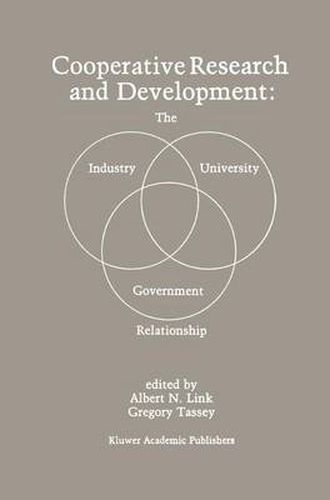Readings Newsletter
Become a Readings Member to make your shopping experience even easier.
Sign in or sign up for free!
You’re not far away from qualifying for FREE standard shipping within Australia
You’ve qualified for FREE standard shipping within Australia
The cart is loading…






This title is printed to order. This book may have been self-published. If so, we cannot guarantee the quality of the content. In the main most books will have gone through the editing process however some may not. We therefore suggest that you be aware of this before ordering this book. If in doubt check either the author or publisher’s details as we are unable to accept any returns unless they are faulty. Please contact us if you have any questions.
We must all hang together or surely we will all hang separately. Benjamin Franklin The significant apathy that characterized relationships between indus try and universities and the adversarial nature of relationships between industry and government have both faded rapidly in the 1980s as the realities of global competition have surfaced in the United States. Both industry and government leaders articulate a number of constructs for regaining our competitiveness in world markets. One of the more fre quent strategies prescribed in this new competitiveness era is cooperation. Different individuals or groups may espouse different definitions, inter pretations, or areas of emphasis, but the overall importance of this concept is substantial. Although examples of cooperative research have existed for several decades, the number and variety of relationships have expanded rapidly in the 1980s as corporations, universities, and governments have embraced this strategy. Joint ventures involving two or three firms increased from under 200 per year in the 1970s to over 400 per year by the mid-1980s. Multiple-firm cooperative arrangements are a more recent phenomenon, made possible by the National Cooperative Research Act of 1984. By mid- 1988,81 of these industry-level consortia had formed under the provisions of the 1984 Act. The rapid growth in cooperative research and development (R&D) is primarily a response to the pressures of international competition. As a corporate strategy, cooperative R&D meets short-term needs for assets to implement new approaches for coping with intensifying competition.
$9.00 standard shipping within Australia
FREE standard shipping within Australia for orders over $100.00
Express & International shipping calculated at checkout
This title is printed to order. This book may have been self-published. If so, we cannot guarantee the quality of the content. In the main most books will have gone through the editing process however some may not. We therefore suggest that you be aware of this before ordering this book. If in doubt check either the author or publisher’s details as we are unable to accept any returns unless they are faulty. Please contact us if you have any questions.
We must all hang together or surely we will all hang separately. Benjamin Franklin The significant apathy that characterized relationships between indus try and universities and the adversarial nature of relationships between industry and government have both faded rapidly in the 1980s as the realities of global competition have surfaced in the United States. Both industry and government leaders articulate a number of constructs for regaining our competitiveness in world markets. One of the more fre quent strategies prescribed in this new competitiveness era is cooperation. Different individuals or groups may espouse different definitions, inter pretations, or areas of emphasis, but the overall importance of this concept is substantial. Although examples of cooperative research have existed for several decades, the number and variety of relationships have expanded rapidly in the 1980s as corporations, universities, and governments have embraced this strategy. Joint ventures involving two or three firms increased from under 200 per year in the 1970s to over 400 per year by the mid-1980s. Multiple-firm cooperative arrangements are a more recent phenomenon, made possible by the National Cooperative Research Act of 1984. By mid- 1988,81 of these industry-level consortia had formed under the provisions of the 1984 Act. The rapid growth in cooperative research and development (R&D) is primarily a response to the pressures of international competition. As a corporate strategy, cooperative R&D meets short-term needs for assets to implement new approaches for coping with intensifying competition.